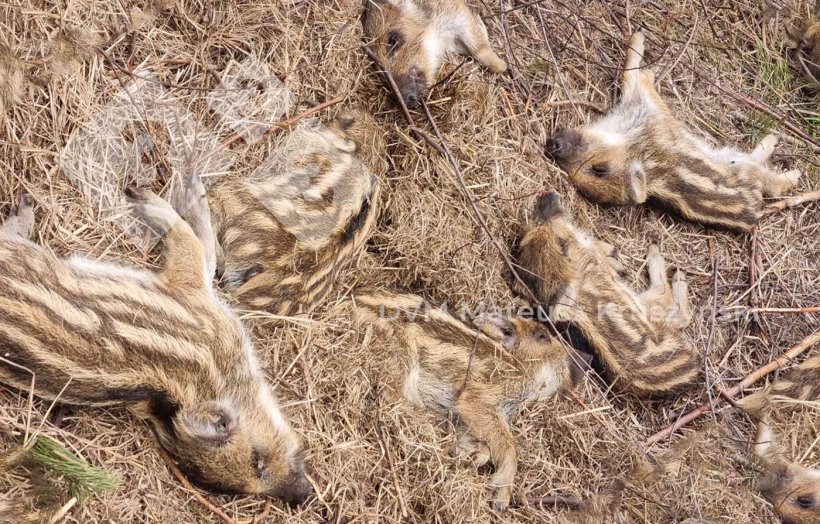In Poland, the first outbreak of African swine fever (ASF) was detected in February 2014 in a wild boar found near the border with Belarus, and 5 months later in domestic pigs. Evolution of outbreaks is shown in figures 1 and 2.
Figure 1. Occurrence of ASF outbreaks in wild boar in Poland 2014-2024 according to GIW (end of August 2024).

From the beginning of the ASF epizootic, a seasonal pattern of outbreaks in domestic pigs has been observed. Most outbreaks are discovered between the end of June and the end of September, while the trend is the opposite for wild boar; most ASF outbreaks are detected in autumn, winter, and spring. Typically, the first outbreaks occur in early June ASF. The last “seasonal” ones are found in late September. The reasons for the seasonality of ASF in pigs are primarily found in farmers' activities, which are associated with the intensification of fieldwork. During this period, there is more frequent than normal “neighborly borrowing” of agricultural equipment from each other. In Poland, people traditionally visit the forest for berry and mushroom picking during the summer. Field work may force wild boars to leave their habitat (e.g., cornfields), increasing the risk of their movement near pig farms. During the summer, hunters also increase their activity, affecting the movement of wild boars. The end of spring and summer increases wild boar activity as they move farther, often searching for water. It leads to more frequent contact between infected and healthy individuals. During late spring and summer, there is greater insect activity, which may contribute to the mechanical transmission of ASF virus (ASFV).
Starting in 2014, the ASFV broke down further geographical barriers and consistently spread throughout the country. Initially, the rate of spread of ASFV among wild boar was relatively low, ranging between 10 - 12 km per year, in a west and south direction.
Evidence of the important role of humans in the long-distance transmission of ASFV was provided by an outbreak of ASF in wild boar in late 2017 located in an area more than 100 km away from the restricted zones in eastern Poland, which was clearly related to human involvement in the transmission of ASFV.
Figure 2. Occurrence of ASF pig outbreaks in Poland 2014-2024 according to GIW (end of August 2024).

The data shows that, for several reasons, Poland has not managed to control ASF in both - wild boar and pigs. The main reason is that from the beginning the determination of different institutions responsible for combating ASF in Poland was insufficient.
First of all, the need to significantly reduce the wild boar population, due to several reasons, was underestimated. More importantly, proper attention has not been given to actively searching for and disposing of dead wild boars. This is concerning because both factors involved in eradicating ASF are, or should be, aware. A significant reduction in the circulation of ASFV in the wild boar population is a condition for success in the fight against ASF in pigs.
As mentioned, wild boar are the most important reservoir and source of ASFV in the environment. Therefore, the migration of these animals plays a significant role in the spread of the virus in their environment.
The spread of infection in wild boar is influenced by their population density and the density and size of forest complexes. Every effort should be made to reduce wild boar densities. ASFV spreads in the environment, mainly through the remains of dead wild boar. Depending on weather conditions, wild boar found dead due to ASF and not seen for a few days, months, or even a year can be a source of the virus infecting healthy individuals.
Another significant reason for the failure to combat ASF, especially in the first years of the epidemic of the disease, was the low level of knowledge and underestimation of the importance of biosecurity in protecting farms against ASF. In the case of pigs, at the beginning of the ASF epizootic in Poland, it seemed that the problem would affect only the small-scale pig holdings. This trend visibly reversed after the 2019 and 2020 outbreaks in large-scale farms with several thousand pigs appeared. It is important to state that biosecurity is the only effective method of protecting pigs from ASF. If it is well organized and observed daily, it may preserve the pig herd from the disease. It must be underlined that attitudes to biosecurity have fundamentally changed among Polish pig farmers over the last 10 years. The percentage of farms that have implemented and comply with the basic principles of biosecurity is now significantly higher than 10 years ago. Among others, this is due to the liquidation of backyards and small-scale farms, which usually do not follow biosecurity rules. As in other countries, in Poland, ASF influences the structure of pig farming. Small pig holdings are disappearing, and larger farms are remaining and growing. During the 10 years of ASF in Poland, the number of herds have decreased from about 200,000 to 50,000.
In conclusion, one can be tempted to say that the measures (active search for dead wild boars, significant reduction of the wild boar population, and implementation of biosecurity principles on all pig farms) taken over the last 10 years to limit the spread of ASF in wild boar and pig populations were insufficient. Polish experience also shows that combating ASF is impossible without involving many different state services in this process.
pig333.com



